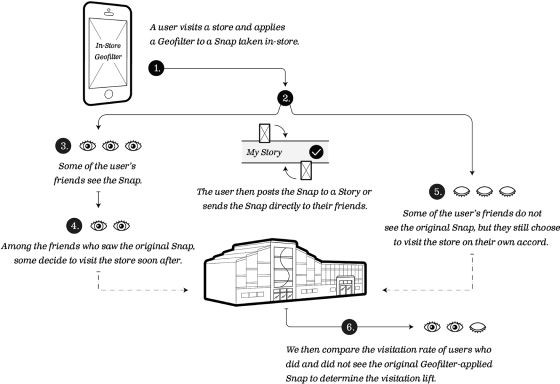You all know Snapchat, the service that allows you to send annoying selfies to friends and colleagues. Most of you are also familiar with using so-called “geofilters”. These are location specific filters that you can put over your picture at Disneyland and suddenly all your friends can see where the picture was taken.

Previously, marketers had little idea about how effective these custom filters actually are. People might use them but do they drive more people to the store or in the case above into Disneyland?
Snap now grants selected companies access to more precise tracking and conversion statistics with the intention to make advertising through Snapchat a more viable strategy. The intuition behind Snap to Store is explained in the illustration below.

Basically, as long as people are using the application, Snap can see the users physical location. In conjunction with the information of whether or not the user viewed a snap with the respective store depicted in it, Snap can then calculate how effective the geofilter was in driving visits to that particular store.
Everybody can now decide whether they are cool with the Snaps usage of user data or not. If not, you can just disallow Snapchat to have access to your GPS data, the geofilters are then gone obviously.
More intriguing is the question of the impact that this has on companies trying to generate location-specific advertisements. Is Snap trying to compete with Facebook or Google or do they follow a different approach? In my opinion, they follow a different path here. Viewing a company related filter over a snap from your friend creates a distinct message from a standard advertisement. It’s more personal and thus could be more effective in influencing people to visit the store. It will certainly be interesting to see the first statements of companies describing their experience with the Snap to Store tracking functionality.
Do you think that this B2B feature makes Snapchat more feasible for advertising? Is such a functionality in competition with Facebook/Google or can Snap create a market niche? Post your comments below!

According to Snapchat, snaps with these geofilters already accounted for more than a million of the messages sent every day on the platform. I do feel that the idea of brands making geofilters is a brilliant, and I also find it interesting that Snapchat is getting a lot of attention for something that seems pretty basic since Facebook has been selling geostickers since 2013.
Snapchat’s filters, both branded and unbranded alike, are assets that enable someone to personalize their communications, not only publicly on their stories, but privately, too. Therefore, I do feel that Snapchat’s geofilters make it an interactive advertising platform and could provide Snapchat with an opportunity to create its own market niche through filter innovations.
LikeLiked by 1 person
Great article Paul! Very interesting insight into this filter. I’ve seen it before on snapchat and never thought of it as a way to increase traffic to that particular shop. As long as the shop provides a positive experience to the consumer using the filter, it can only be beneficial in terms of creating more exposure and awareness.
LikeLiked by 1 person